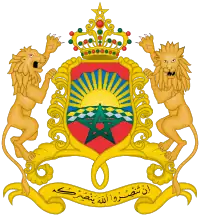Kasbah of the Udayas
The Kasbah of the Udayas (Arabic: قصبة الأوداية Qasbat al-Awdāya,[1] also الوداية al-Widaya) (also spelled "Oudaias" or "Oudayas") is a kasbah (citadel) in Rabat, Morocco. It is located at the mouth of the Bou Regreg river, opposite Salé, and adjacent to the old medina of Rabat. It is listed, along with other sites in Rabat, as a UNESCO World Heritage Site.[2]
| Kasbah of the Udayas | |
|---|---|
| Native names Arabic: قصبة الوداية French: Kasbah des Oudaias | |
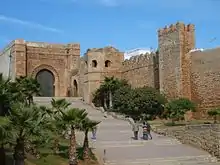 The walls of the kasbah and the main Almohad gate, Bab Oudaia. | |
| Type | Kasbah |
| Location | Rabat, Morocco |
| Coordinates | 34°01′54.51″N 6°50′09.95″W |
| Built | 12th century |
| Architectural style(s) | Moroccan Kasbah |
 Location of Kasbah of the Udayas in Morocco | |
Part of a series on the |
|---|
| History of Morocco |
 |
|
|
Name
The original name of the qasbah was Qasbat al-Awdāya (قصبة الأوداية).[1] Awdāya is the plural of the word wadi, meaning "river valley."[3] The use of al-Widaya (الوداية) instead of al-Awdāya has become popular.
History
In the 10th century the Umayyads of Cordoba, or their Zenata Berber allies in the region, founded a ribat or fortified monastery/outpost in this area, to defend against the Barghawata Berbers who had established a Kharijite state to the south.[4] This ribat was most likely on the same site as the current Kasbah of the Udayas but its location has not been confirmed by historians.[4] In any case, one of the last Almoravid emirs, Tashfin ibn Ali (ruled 1143-45) built a new ribat on the site of the current kasbah during his efforts to repel the Almohads,[4][5] but the Almohads defeated the Almoravids and destroyed the ribat.[6] In 1150 or 1151 the Almohad caliph Abd al-Mu'min built a new kasbah (citadel) over the site of the former ribat, within which he included a palace and a mosque.[4][6][7] He also had an underground canal dug to divert a water source to the area, allowing for future settlement and urbanization.[5] His successor, Abu Yusuf Ya'qub al-Mansur (ruled 1184–1199), embarked on a huge project to construct a new fortified imperial capital, called al-Mahdiyya or Ribat al-Fath, on the site of what is now the medina (old city) of Rabat, with new walls extending over a vast area beyond the old kasbah.[5] This project also included the construction of an enormous mosque (the remains of which include the Hassan Tower) and of new grand gateways including Bab er-Rouah, a major gate in the city's western wall, and what is now called Bab Udaya or Bab al-Kbir, the gate of the Kasbah. After Abu Yusuf Ya'qub's death in 1184 the mosque and the capital remained unfinished and his successors lacked the resources or the will to finish it.[5] The kasbah itself became essentially abandoned.[6] Meanwhile, the town of Salé across the river, grew in importance and was developed during the Marinid era.[6][4]
In 1609, Philip III decreed the expulsion of all Moriscos (people of Muslim or Moorish descent) from Spain. About 2000 of these refugees, originally from the town of Hornachos near Badajoz, Spain, settled around Salé and occupied the kasbah, attracting between 5000 and 14,000 other Moriscos to join them.[6] They established their own autonomous republic, referred as the Republic of Salé (or Republic of Bou Regreg), which served as a base for corsairs: pirates, also known as the "Salé Rovers", who preyed on merchant ships around Western Europe and generally sold the crews into slavery.[6][8] During this time (early 17th century) they built a broad platform on the kasbah's northeastern edge, overlooking the river, which was used for semaphore signalling.[4][6] A warehouse structure was later added on it during the 18th century, used today as a school and a carpet workshop. Below the platform, to the north, was a sqala, a seaside fortification and artillery platform, while just 25 meters upriver from this, to the east, was the "Tower of the Corsairs", also added in the 18th century.[6] This was a round tower with openings for 4 canons aimed at the river. The tower rose only 3 meters above the water and was hidden from view behind the sqala, thus allowing its canons to catch pursuing enemy ships by surprise.[6] The Republic of Salé remained outside the control of central government until 1666, when the Alaouite sultan Moulay Rashid took over the area and placed the corsairs under his authority.[6]
The southern part of the Kasbah today was added during the Alaouite period, especially in the 18th century.[4][5] It includes a palace or royal pavilion built by Sultan Moulay Ismail (ruled 1672-1727) at the end of the 17th century and serving today as a museum.[4][6] Moulay Ismail was also responsible for settling the Udaya (or Oudaia) Arab tribe in the kasbah and in Rabat to serve as a counterbalancing force against other unruly tribes in the region, thus giving the kasbah its current name, Kasbah of the Udayas.[6][8]
Rabat (with the Kasbah included within it) was added to the UNESCO World Heritage Tentative List on July 20, 2006 in the Cultural category. It was granted World Heritage Status in 2012.[9][10][11][12]
Major structures and monuments
The upper or northern part of the kasbah, above the museum, dates mostly from its foundation/reconstruction in the Almohad period under Caliph Ya'qub al-Mansur in the 12th century, while the lower parts date from the 18th century during the Alaouite period.[6][4] The northern part of the kasbah is centered around the Street of the Mosque (Rue Jamaa), which runs between the Bab Oudaia gate and the semaphore platform, passing by the kasbah's Old Mosque.[13] The southern part is taken up to a large extent by the Andalusian Gardens, the Oudayas Museum, and a longstanding nearby café and terrace known as Café Maure.[13]
Gate of the Kasbah (Bab Oudaia)
The monumental gate of the kasbah, located uphill and overlooking Rabat below, is considered one of most beautiful gates of Almohad and Moroccan architecture.[5][4][6][14] It goes by the name Bab Oudaia ("Udaya Gate") or Bab al-Kbir ("Great Gate").[15][16] It was built by the Almohad caliph Ya'qub al-Mansur between 1195 and 1199, inserted into the previous walls of the kasbah built by Abd al-Mu'min around 1150.[4][14] It has both an outer facade (facing southeast towards the city) and an inner facade (facing northeast onto the Street of the Mosque), both richly decorated. The massive gate was largely ceremonial and had little defensive value, given its position already inside the city walls; unlike Bab er-Rouah, the ornate western gate in Rabat's city walls, built around the same time, it was not flanked by true defensive towers.[4]
The carved decoration around the horseshoe arch entrance features a curved band of interlacing geometric forms (specifically, a pattern known as darj wa ktaf, commonly seen in Moroccan architecture), set inside a rectangular frame outlined by a Qur'anic inscription frieze in Kufic Arabic script. The inscription includes the Surat As-Saff (61:9-13), which contains references to jihad, as befitting the kasbah's role as a symbol of Almohad military might.[7] In the corners between this curved band and the inscription are carved arabesque or floral patterns with a palmette or scallop shell at their middle, and above these is another carved frieze of palmettes.[4] Further above all this is another band of geometric carving, at either side of which are two ornate corbels, set above decorative engaged columns, which probably once supported a shallow roof or canopy covered in green tiles.[4] At both corners of the horseshoe arch (at the bottom of the curved band of geometric carvings) are serpentine "S"-like forms, probably representing eels, which are a very rare motif in Almohad or Moroccan architecture.[6][14] The external facade of the inner gate, facing towards the kasbah, has carved decoration very similar to that of the outer gate, but with minor differences in the choice of geometric forms.[14]
Inside, the gate has three chambers: two square chambers covered by domes and a third chamber covered by a barrel vault.[4][14] Entering through the main outer gate, each chamber is reached by a short flight of stairs. The second chamber opens to the inner gate, while the third chamber (rarely open to visitors) can be accessed by a smaller doorway from the second chamber.[4][14] The archways inside the two first chambers feature decorative geometric carvings similar to the outline of the outer gates, but without the rest of the extensive decoration around them.[14]
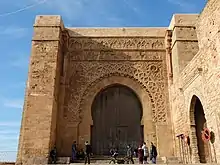 The facade of the outer gate.
The facade of the outer gate. Details of the facade of the outer gate.
Details of the facade of the outer gate. The eel motif at the base of the arches.
The eel motif at the base of the arches. The chambers inside the gate (seen at night).
The chambers inside the gate (seen at night). The facade of the inner gate.
The facade of the inner gate. Details of the facade of the inner gate.
Details of the facade of the inner gate.
The Old Mosque (Mosque of the Kasbah)
The oldest current structure at the site of the Kasbah is its main mosque, the Jama' al-'Atiqa ("Old Mosque"). Dating from Abd al-Mu'min's construction in 1150, it was largely restored in the 18th century, during the reign of Sultan Mohammed ben Abdallah, by an English corsair known as Ahmed el-Inglizi.[6][4][17] The minaret dates from this later restoration.[6]
The mosque measures about 26.5 by 25 metres but its outline is partly irregular due to modifications over the centuries.[17] Its exterior is mainly made of stone while the arches of the interior are made in brick.[17] Like many medieval western Islamic mosques, its qibla (direction of prayer) is not aligned with the true direction of Mecca but faces mostly south, following an older tradition based on a hadith.[18] The mosque can be entered via four horseshoe arch doorways.[17] Inside is a rectangular courtyard (sahn) surrounded by galleries on three sides and by the prayer hall to the south/southeast. The layout of the prayer hall follows the typical "T"-plan of medieval Moroccan mosques: it is split by rows of arches into seven "naves" running perpendicular to the qibla wall, of which the central one is wider than the others and is aligned with the mihrab (niche symbolizing the direction of prayer).[17] The walls and arches of the mosque's interior are painted white, with the lower walls decorated with Moroccan tilework while the upper walls and the spandrels of the arches are decorated with carved stucco.[18] The mihrab is the most richly decorated feature, again featuring ornate patterns in carved stucco. This decoration, however, is of recent date.[17]
One unusual feature of the mosque's layout is the fact that the minaret stood separate from the rest of the mosque and behind the qibla (southeastern) wall, and was only connected to the mosque in 1940.[17][18] The minaret is made of stone and has a square shaft measuring about 4.55 meters to one side.[17] It is modestly decorated with blind arches on its facades.[6]
 Doorway of the Old Mosque in the kasbah (just off the main street).
Doorway of the Old Mosque in the kasbah (just off the main street).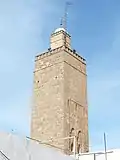 Minaret of the Old Mosque in the kasbah.
Minaret of the Old Mosque in the kasbah. Southeastern facade of the minaret.
Southeastern facade of the minaret.
Oudayas Museum (Pavilion of Moulay Ismail)
The southern part of the kasbah includes a former pavilion or palace residence built by Sultan Moulay Ismail (ruled 1672-1727) at the end of the 17th century.[4][6] The building is centered around a main courtyard and is distinguished on the outside by a tower. For a while, the palace also served as a madrasa.[6] In 1915, during the French Protectorate over Morocco, the building was converted into a museum on the initiative of Prosper Ricard, director of the Service des Arts Indigènes under Lyautey.[19] It became an ethnographic museum with a collection initially made up of donations from Prosper Ricard himself, Alfred Bel, and Jean Besancenot.[19] The museum's collection expanded to include jewellery, musical instruments, ceramics, Qur'ans and manuscripts (some as old as the 12th century), costumes, silks, and carpets, all from different parts of the country.[6][20] In 2006, following a restoration, it became the National Jewellery Museum, devoted to the history of Moroccan jewellery, along with some other objects.[19][20] In 2014, the museum was closed for long-term refurbishments by the National Foundation of Museums.[21][22][23]
.jpg.webp) The tower of the pavilion of Moulay Ismail (Oudayas Museum).
The tower of the pavilion of Moulay Ismail (Oudayas Museum). The main courtyard of the residential pavilion of Moulay Ismail, now part of the Oudayas Museum.
The main courtyard of the residential pavilion of Moulay Ismail, now part of the Oudayas Museum. One of the rooms or vestibules, with decoration including zellij tilework.
One of the rooms or vestibules, with decoration including zellij tilework. A room in the former hammam (bathhouse) of the residential pavilion.
A room in the former hammam (bathhouse) of the residential pavilion.
Andalusian Garden
The "Andalusian Garden" next to the museum was created between 1915 and 1918, during the French protectorate in Morocco, under Maurice Tranchant De Lunel.[6][24] It is a formal garden ostensibly inspired by the Moorish gardens of al-Andalus (Andalucia) and features a variety of trees and plants such as bougainvillea and citrus trees.[25] It is frequented by tourists and locals.[26]
 The Andalusian Gardens of the kasbah, looking towards the pavilion of Moulay Ismail.
The Andalusian Gardens of the kasbah, looking towards the pavilion of Moulay Ismail. The walls and one of the towers surrounding the gardens.
The walls and one of the towers surrounding the gardens..jpg.webp) View of the Andalusian Gardens around 1920.
View of the Andalusian Gardens around 1920.
Current status
Today, the Kasbah remains a popular free tourist attraction within Rabat, offering scenic views of the Plage of Rabat, the Bou Regreg river, neighboring Salé, and the Atlantic Ocean. It is mostly occupied by a residential neighborhood, known for its distinct blue and white walls. Today the Kasbah is also a UNESCO World Heritage Site.[2]
A site adjacent to the Kasbah is used as one of the concert venues for the annual Mawazine music festival in Rabat.[27]
Gallery
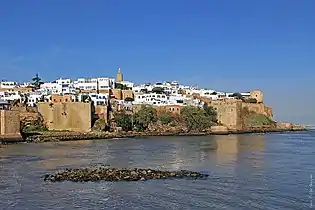 The Kasbah of the Udayas overlooking the Bou Regreg River.
The Kasbah of the Udayas overlooking the Bou Regreg River.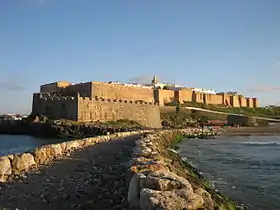 View of the Kasbah from the north.
View of the Kasbah from the north.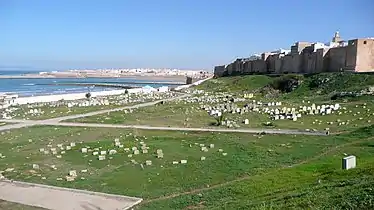 View of the kasbah from the northwest, with a nearby cemetery.
View of the kasbah from the northwest, with a nearby cemetery..jpg.webp) View of the Kasbah from the south, including 18th-century walls.
View of the Kasbah from the south, including 18th-century walls. View of riverside fortifications, including the Sqala and the Corsairs' Tower on the right below the main semaphore platform above on the left.
View of riverside fortifications, including the Sqala and the Corsairs' Tower on the right below the main semaphore platform above on the left..jpg.webp) View of the Kasbah, including the minaret of the Old Mosque.
View of the Kasbah, including the minaret of the Old Mosque.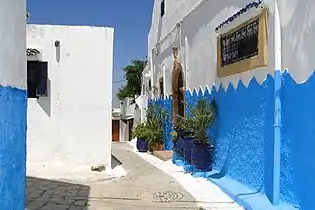 A typical street inside the kasbah today.
A typical street inside the kasbah today.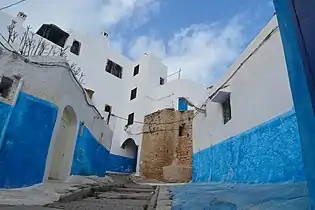 Another street (Rue Bazou) inside the kasbah, passing through an archway.
Another street (Rue Bazou) inside the kasbah, passing through an archway.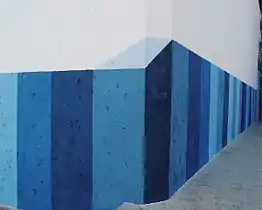 Optical illusion painted on corner of a house in the kasbah.
Optical illusion painted on corner of a house in the kasbah.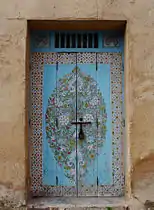 An ornately painted door in the kasbah, near the museum.
An ornately painted door in the kasbah, near the museum.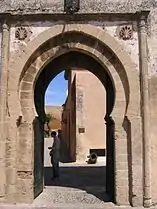 A gate in the kasbah's western wall near the Andalusian Gardens and the museum.
A gate in the kasbah's western wall near the Andalusian Gardens and the museum.
References
| Wikimedia Commons has media related to Kasbah of the Udayas. |
- "قصبة الأوداية.. عبق التاريخ وصدى الأندلس بالمغرب". www.aljazeera.net (in Arabic). Retrieved 2020-05-20.
- Centre, UNESCO World Heritage. "Rabat, Modern Capital and Historic City: a Shared Heritage". UNESCO World Heritage Centre. Retrieved 2019-12-24.
- Team, Almaany. "تعريف و شرح و معنى الأوداية بالعربي في معاجم اللغة العربية معجم المعاني الجامع، المعجم الوسيط ،اللغة العربية المعاصرة ،الرائد ،لسان العرب ،القاموس المحيط - معجم عربي عربي صفحة 1". www.almaany.com. Retrieved 2020-05-20.
- Parker, Richard (1981). A practical guide to Islamic Monuments in Morocco. Charlottesville, VA: The Baraka Press. pp. 75–85.
- Bennison, Amira K. (2016). The Almoravid and Almohad Empires. Edinburgh University Press. pp. 309–10, 322–25.
- Touri, Abdelaziz; Benaboud, Mhammad; Boujibar El-Khatib, Naïma; Lakhdar, Kamal; Mezzine, Mohamed (2010). Le Maroc andalou : à la découverte d'un art de vivre (2 ed.). Ministère des Affaires Culturelles du Royaume du Maroc & Museum With No Frontiers. ISBN 978-3902782311.
- Lintz, Yannick; Déléry, Claire; Tuil Leonetti, Bulle (2014). Le Maroc médiéval: Un empire de l'Afrique à l'Espagne. Paris: Louvre éditions. pp. 306–308. ISBN 9782350314907.
- Abun-Nasr, Jamil (1987). A history of the Maghrib in the Islamic period. Cambridge: Cambridge University Press. ISBN 0521337674.
- UNESCO World Heritage Centre. "Qasba des Oudaïas - UNESCO World Heritage Centre".
- "Rabat, Modern Capital and Historic City: a Shared Heritage". UNESCO. 2012. Retrieved 2013-10-06.
- "Rabat". World Heritage Site. September 2013. Archived from the original on 2013-08-17. Retrieved 2013-10-06.
- "Rabat Named UNESCO World Heritage Site". Caribbean News Digital. 2012-11-23. Archived from the original on 2014-02-22. Retrieved 2013-10-06.
- "Kasbah des Oudaias | Rabat, Morocco Attractions". www.lonelyplanet.com. Retrieved 2019-12-26.
- Salmon, Xavier (2018). Maroc Almoravide et Almohade: Architecture et décors au temps des conquérants, 1055-1269. Paris: LienArt.
- "Rabat, modern capital and historic city (Morocco)". UNESCO.
- "Bab Oudaia | Rabat, Morocco Attractions". www.lonelyplanet.com. Retrieved 2019-12-24.
- France, PASS Technologie, 26, rue Louis Braille, 75012 Paris. "Al masjid al-Atiq (Kasbah des Oudaïa)". www.idpc.ma (in French). Retrieved 2020-01-02.
- "Masjid al-Atiq". Archnet. Retrieved 2020-01-02.
- "MUSÉE DES OUDAYAS". Biennale de Rabat 2019 (in French). Retrieved 2019-12-24.
- "MWNF - Museum With No Frontiers". www.museumwnf.org. Retrieved 2019-12-24.
- "Musée national des bijoux". Fondation National des Musées (in French). Retrieved 2019-12-24.
- "La collection de parures de Mohammed VI "bientôt" exposée au musée des Oudayas". Telquel.ma (in French). Retrieved 2019-12-24.
- "LE MUSÉE DES OUDAYAS A RABAT EXPOSERA LES BIJOUX DU ROI MOHAMED VI - Actu-Maroc.com". Actu-Maroc (in French). 2019-09-03. Retrieved 2019-12-24.
- "Jardin Andalou des Oudayas – 2ème partie". Rabat-Maroc.net (in French). 2018-02-05. Retrieved 2019-12-24.
- "Andalusian Gardens | Rabat, Morocco Attractions". www.lonelyplanet.com. Retrieved 2020-01-02.
- "Kasbah les Oudaias". Lonely Planet. Retrieved 2019-01-08.
- "برنامج 2018". Mawazine (in Arabic). Retrieved 2019-02-08.
